2023 Santa Cruz Hightower
Wheel Size: 29’’
Travel: 145 mm rear / 150 mm front
Material: Carbon Fiber; Aluminum version coming in 2023
Price:
- Carbon complete bikes $5,499 to $10,699; aluminum options TBD
Blister’s Measured Weight:
- 31.8 lb / 14.4 kg (Hightower CC X01 AXS RSV, size Large)
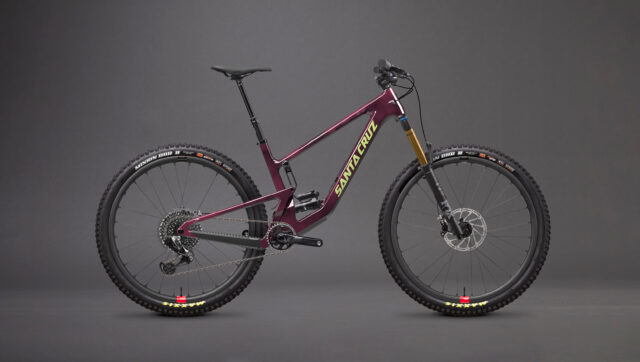
Intro
Santa Cruz’s tagline for the new Hightower is “it’s a mountain bike.” And while that’s inarguably true, it’s not as flippant as it sounds at first blush — the Hightower is supposed to be the most versatile bike in Santa Cruz’s lineup, and the one that more people should be buying than any other. Or at least that’s how Santa Cruz looks at it. But are they right to do so? And how does it compare to the previous version?
The Frame
As with the outgoing Hightower V2, the new V3 bike is offered in aluminum or carbon fiber, with Santa Cruz’s standard C and CC layup options for the latter material. In short, the C frame is a slightly more affordable option, whereas the top-spec CC frames get a fancier layup that trims a little weight, allegedly at no cost to stiffness or durability. The carbon frames are available now, with the aluminum versions following sometime in 2023.
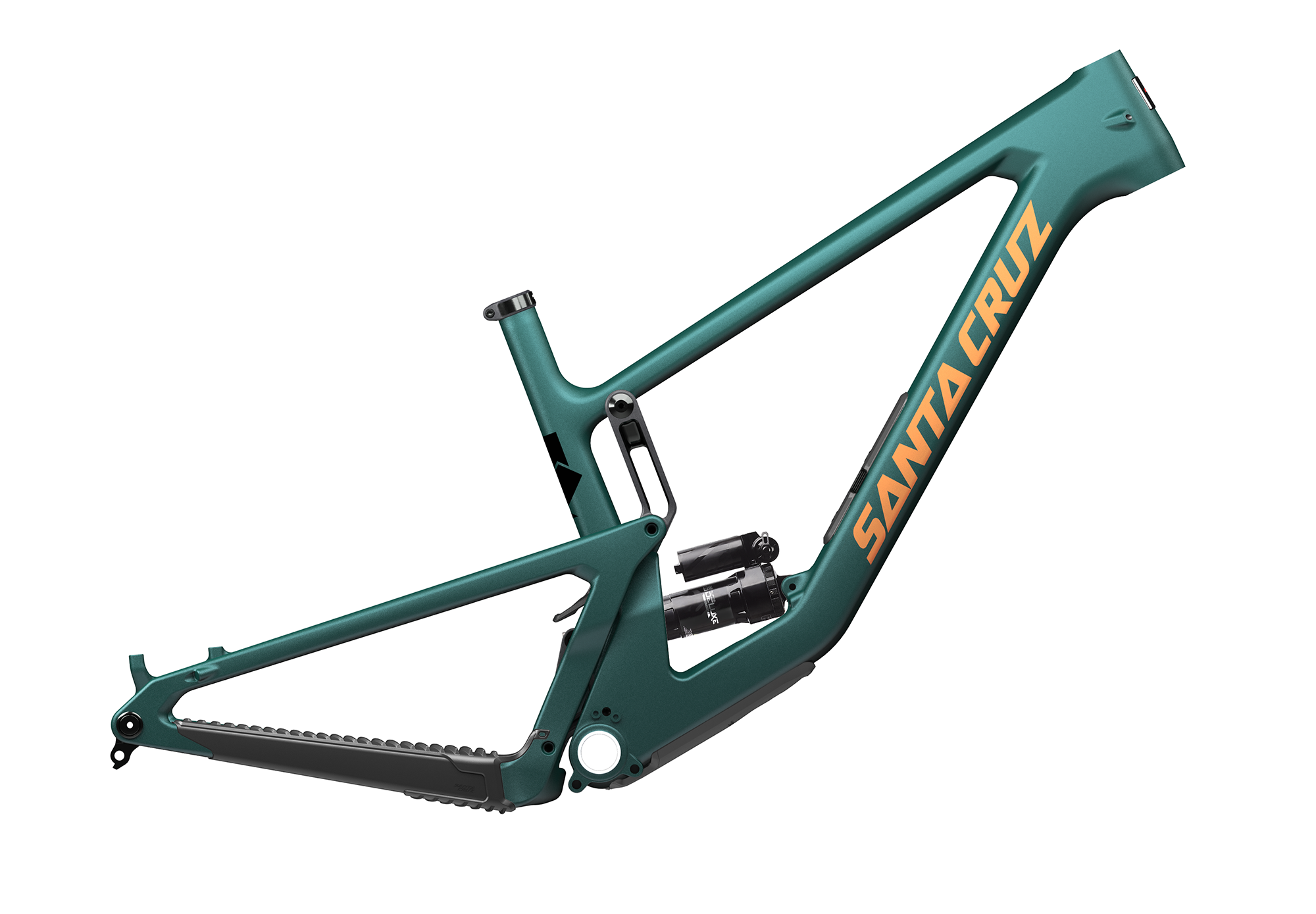
There’s a lot more that hasn’t changed; the Hightower is still a 145mm-travel 29er, designed around a 150 mm fork. It’s still got lower-link-driven VPP suspension, room for a water bottle in the front triangle, fully internal cable routing, a threaded bottom bracket shell, and ISCG 05 tabs. The geometry adjusting flip-chip also remains (more on that below).
But the stuff that has changed is pretty important — the geometry has gotten tweaked, the suspension kinematics reworked, and there’s now a “Glovebox” storage compartment in the downtube — on both the aluminum and carbon models. The derailleur is also now a UDH (which we’re pretty excited to see catching on and actually becoming a real standard instead of an XKCD comic).
Let’s start with the suspension: Santa Cruz has made the leverage curve both more linear and a little more progressive, going from just over 3:1 at topout to a little under 2.4:1 in a fairly straight line; the prior generation bike wasn’t wildly different, but had slightly less progression overall, and the curve flattened out notably deep in the travel. Santa Cruz says these tweaks add up to improved bottom-out resistance and a bit more consistency in suspension performance throughout the travel, and on paper that checks out.
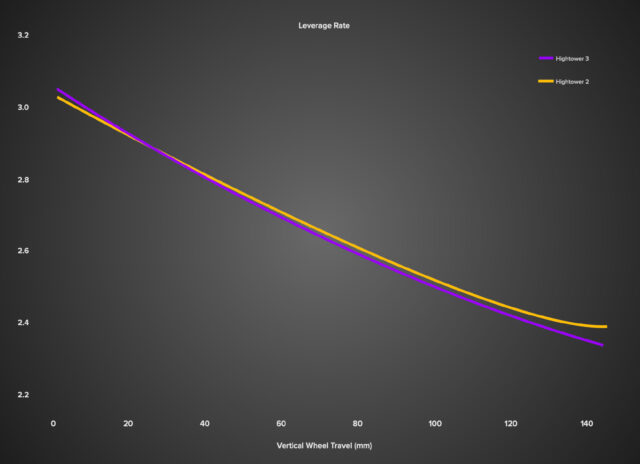
The new Hightower V3 also has slightly less anti-squat in the first 40% or so of travel as compared to the V2 bike, but it’s still on the higher side, at a little over 130% around sag. Santa Cruz says that the slightly more moderate anti-squat makes for better sensitivity early in the travel due to reduced interaction between the suspension and chain forces. That checks out too, though the change should be pretty modest — we’re talking about a change of less than 10 percentage points around sag. That said, the slightly more progressive suspension should help with initial sensitivity too, so it’ll be interesting to see how much of a difference the combined changes have made.
[And if all of that suspension talk didn’t make much sense, check out the Suspension Kinematics section of our recently updated Mountain Bike Buyer’s Guide.]
Santa Cruz’s “Glovebox” downtube storage debuted with the new Megatower earlier this year, and the same system carries over to the Hightower — there’s a quick-release lid underneath the bottle cage, and an included “Tool Wallet” and “Tube Purse” help keep things organized in there. Or if you take those out, there’s room to stuff a lightweight jacket in there, too.

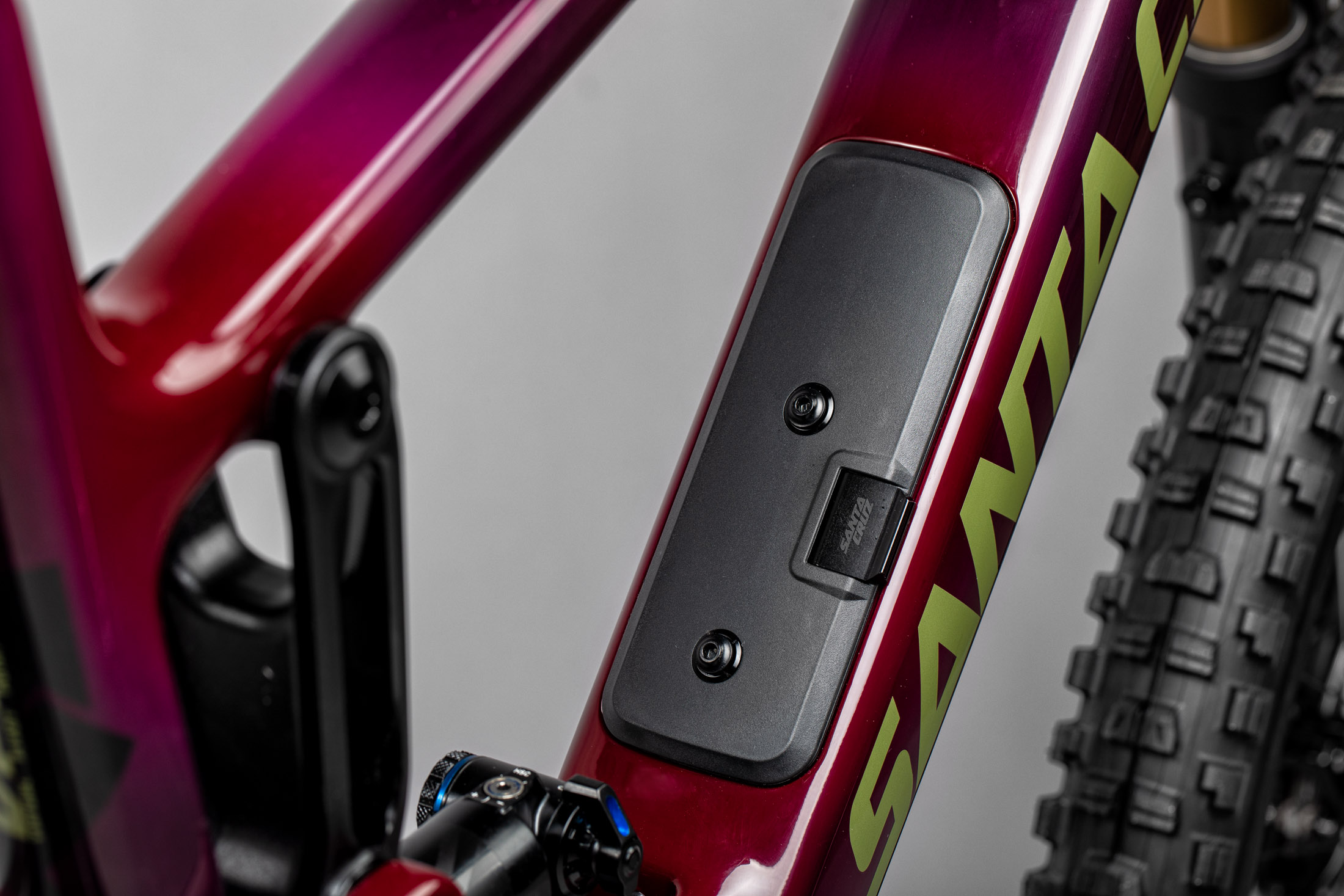
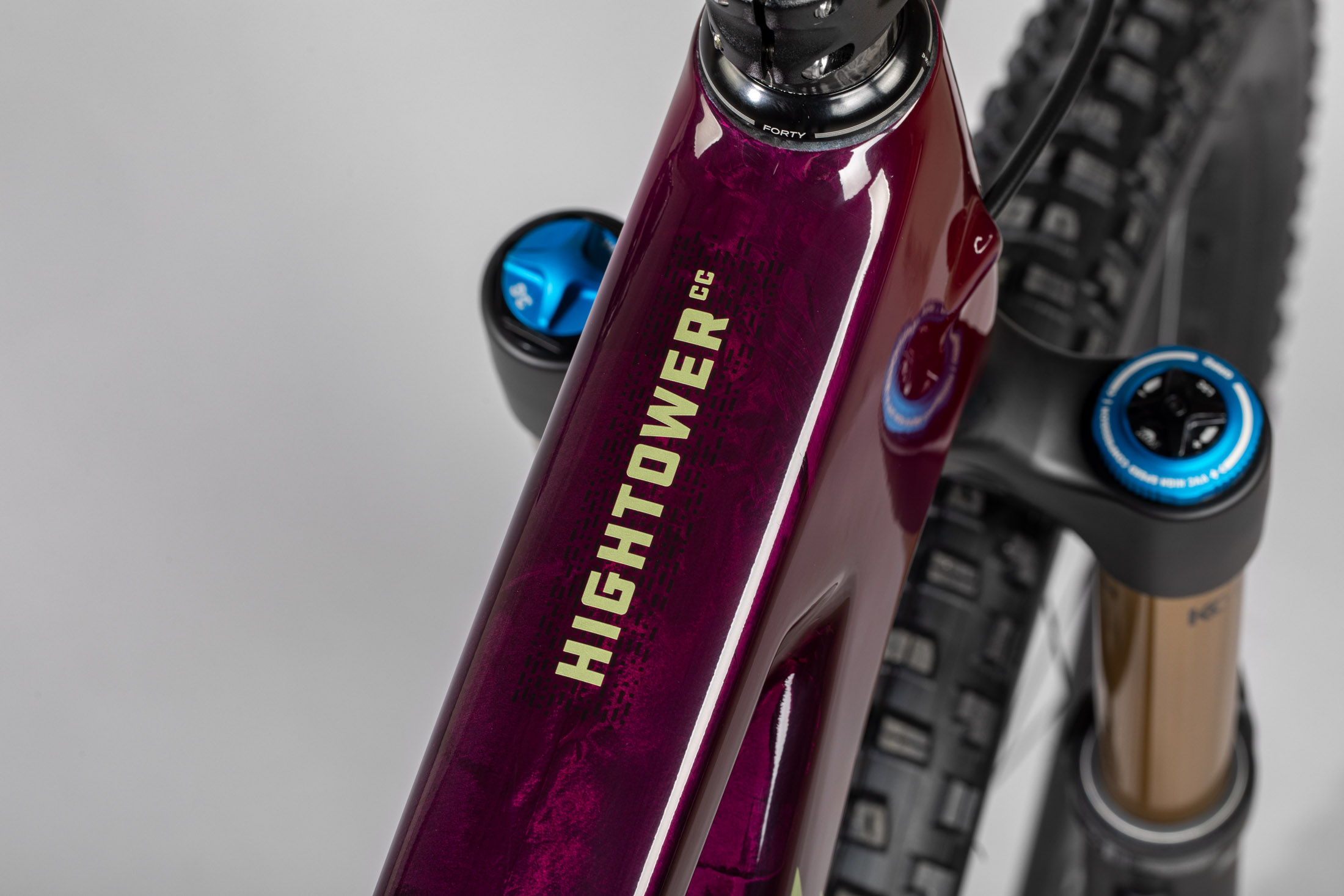
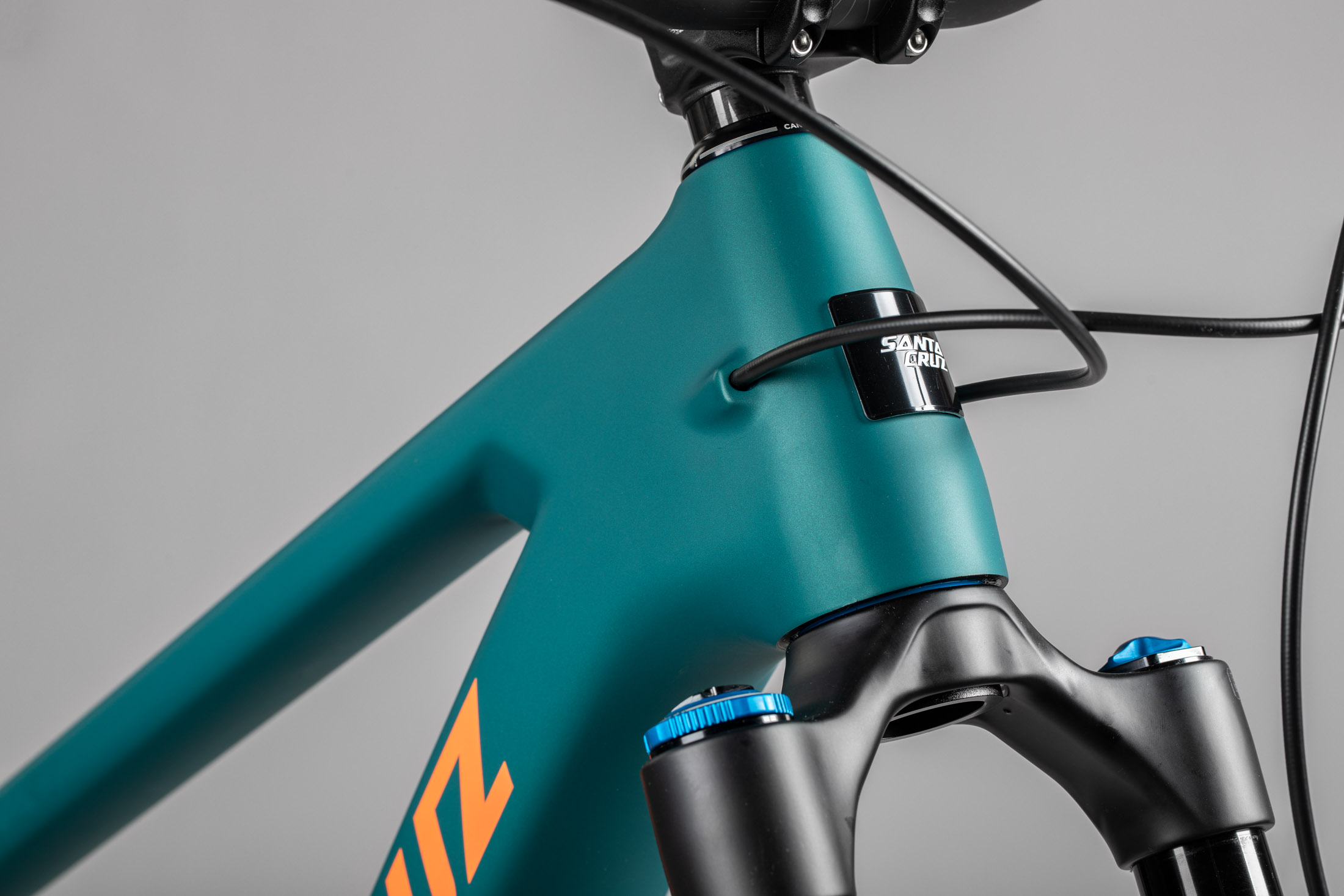
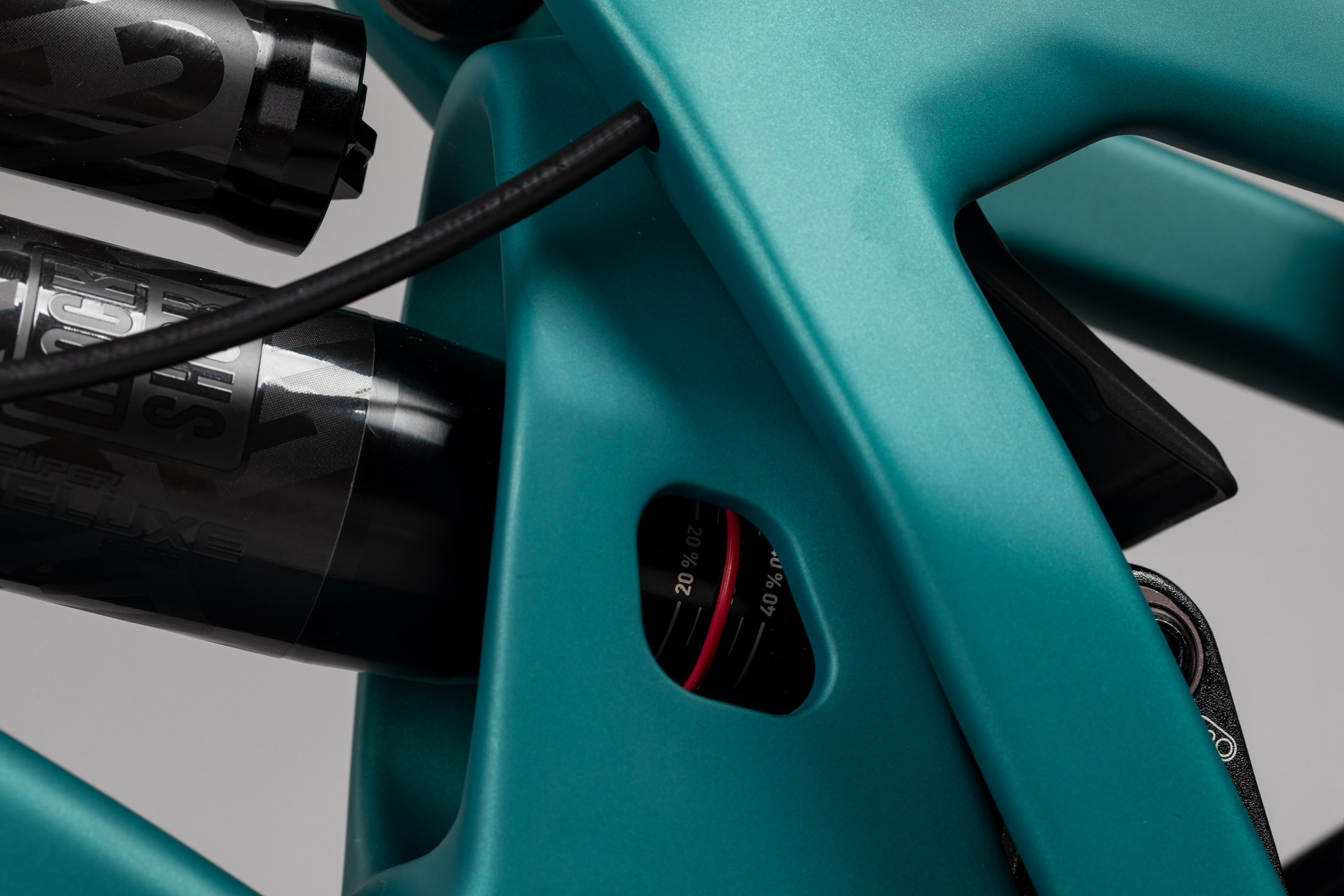
Santa Cruz has also found some other details to tweak. There’s now a hole in the non-drive side of the shock tunnel to make it easier to view the sag indicator, and the shelf at the bottom of the tunnel has been reshaped to direct water away from the lower link pivots. And speaking of the shock tunnel, it’s more compact than that on some of Santa Cruz’s bigger bikes (e.g., the Megatower) which leaves more room for dropper post insertion, but means that coil shocks and some larger-volume air shocks (including the Fox Float X2) don’t fit.
Fit & Geometry
The new Hightower is offered in the same five sizes, Small through XXL, as the prior-generation bike, and while the reach has technically gotten longer, it’s by a whole two millimeters per size — so not much change there. There are bigger changes elsewhere, though. The headtube angle is 0.7° slacker (64.8° or 64.5° depending on flip-chip setting), the seat tube angle has been steepened in the larger sizes (to about 76.5° effective across the board, in the low geometry setting), and the chainstay lengths are now size-specific for all sizes; the XXL Hightower V2 got longer 440 mm stays, but the other four sizes all came in at 434 mm. The new bike gets chainstays ranging from 432 to 444 mm, with 3 mm steps between each size. The stack height has also grown considerably, by between 5 and 15 mm, depending on size.
Santa Cruz has also dropped the bottom bracket height very slightly (just a millimeter or two, depending on flip-chip setting) which they say is just meant to compensate for the slightly more supportive suspension and correspondingly higher ride height on the new bike, rather than make for a real difference in terms of on-trail feel.
All told, the changes that Santa Cruz has made feel more like slight tweaks and refinements of the Hightower recipe than any kind of major overhaul, but the result is a really nice set of numbers that we’d expect to make for a really versatile all-rounder that it’s easy to imagine clicking for a whole lot of riders in a big range of locales.
The Builds
Santa Cruz offers the Hightower in six different builds for now, all with a carbon frame. The R, S, GX and GX AXS feature the more basic Carbon C frame and the top-tier Carbon CC frame is featured on the X01 and X01 AXS RSV builds. All builds get Maxxis Minion DHR2 Exo 2.4’’ tires at both ends (MaxxGrip rubber front, MaxxTerra rear). Kudos to Santa Cruz for the choice of MaxxGrip rubber for the front tire, but the plain Exo casings seem a little wimpy, given the intentions of the bike. It’s not a big Enduro bike that demands DoubleDowns, granted, but I’d rather see Exo+ ones on there.
That quibble aside though, the builds seem nicely thought out — and I’m very into putting the big-gun SRAM Code brakes on the higher-end builds. That’s a part where going overkill is clearly better than coming up short (Santa Cruz does moderate things by going with 180 mm rotors at both ends).
The aluminum options are slated to launch in 2023, with pricing and spec details TBD.

- Fork: RockShox Lyrik
- Shock: Fox Float DPS Performance
- Drivetrain: SRAM NX
- Brakes: SRAM G2 R w/ 200 mm front / 180 mm rear rotors
- Wheels: RaceFace AR30 rims / SRAM MTH hubs
- Dropper Post: SDG Tellis
- Fork: Fox 36 Performance
- Shock: RockShox Super Deluxe Select+
- Drivetrain: SRAM GX
- Brakes: SRAM Code R w/ 180 mm rotors
- Wheels: RaceFace AR30 rims / DT Swiss 370 hubs
- Dropper Post: RockShox Reverb
- Fork: Fox 36 Performance Elite
- Shock: RockShox Super Deluxe Select+
- Drivetrain: SRAM GX AXS
- Brakes: SRAM Code RS w/ 180 mm rotors
- Wheels: RaceFace ARC30 rims / Industry Nine 1/1 hubs
- Dropper Post: RockShox Reverb
- Fork: Fox 36 Factory
- Shock: RockShox Super Deluxe Ultimate
- Drivetrain: SRAM X01
- Brakes: SRAM Code RSC w/ 180 mm rotors
- Wheels: RaceFace ARC30 rims / Industry Nine 1/1 hubs
- Dropper Post: RockShox Reverb
- Fork: Fox 36 Performance Elite
- Shock: RockShox Super Deluxe Select+
- Drivetrain: SRAM GX AXS
- Brakes: SRAM Code RS w/ 180 mm rotors
- Wheels: Reserve 30|HD rims / Industry Nine 1/1 hubs
- Dropper Post: RockShox Reverb
- Fork: Fox 36 Factory
- Shock: RockShox Super Deluxe Ultimate
- Drivetrain: SRAM X01 AXS w/ GX AXS Controller
- Brakes: SRAM Code RSC w/ 180 mm rotors
- Wheels: Reserve 30|HD rims / Industry Nine 1/1 hubs
- Dropper Post: RockShox Reverb
Some Questions / Things We’re Curious About
(1) Santa Cruz has made a lot of little tweaks to the new Hightower, and while none of them look too dramatic on their own, how different does the new bike feel when they’re all added up?
(2) And how does the Hightower stack up against the numerous ~150 mm travel bikes that we’ve been on recently, including the Canyon Spectral, Santa Cruz’s own Bronson, the Guerrilla Gravity Smash, and a whole lot more?
Flash Review
Blister Members can read our Flash Review of the new Santa Cruz Hightower for our initial on-trail impressions. Become a Blister Member now to check out this and all of our Flash Reviews, plus get exclusive deals and discounts on gear, and personalized gear recommendations from us.
Bottom Line (For Now)
We already really liked the outgoing V2 Hightower, but that hasn’t stopped Santa Cruz from trying to improve upon it. While the changes that they’ve made don’t look too dramatic on paper, they all seem like nice refinements of what was already a good, versatile Trail bike. We’ve got a Hightower X01 AXS RSV in for testing, so stay tuned for a full review soon.

FULL REVIEW
The Santa Cruz Hightower has long been a very versatile, well-rounded Trail bike, and the new V3 bike doesn’t stray far from the recipe that made the last one good. But it does have some nice updates and refinements, and the new Hightower still feels totally up-to-date despite not being wildly different from the V2 bike, and it’s still a very easy bike to recommend to a whole lot of different riders.
Fit & Sizing
As tends to be the case with most of Santa Cruz’s bikes, at 6’ / 183 cm tall, I’m near the upper bounds of the recommended sizing for the Large frame and just shy of the start of the XL band, and that feels right. I definitely wouldn’t want the Large to be any smaller but wasn’t really tempted to size up to an XL, either. If the Hightower was meant to be a more stable, game-on bike, that might be different — and I am definitely curious to at least try an XL Megatower to see what that feels like, after testing the Large — but given the intentions of the Hightower, I’m not terribly interested in going super long and trying to turn it into an ultra-stable sled of a bike.
Getting the cockpit set up on the Hightower was also quite straightforward. I trimmed the bar to 790 mm (from 800 mm) and after a little fiddling with bar height via stem spacers, I had things sorted out nicely. I wound up running the stem pretty near the middle of the range afforded by the extra steerer tube (Santa Cruz tends to do a nice job of leaving steerers on the longer side, to give you plenty of room to play with bar height) and I think most people should be able to find a setup that works for them without much trouble.

Climbing
As will be a recurring theme throughout this review, the Hightower’s climbing performance is well-rounded, hitting a nice middle-of-the-road set of traits over emphasizing one performance facet over another. Its pedaling efficiency is good but not as especially snappy as the very most efficient bikes in its travel range, and the Hightower does a nice job of keeping the suspension fairly active and maintaining traction under power.
While the seat tube angle is by no means slack, it is a touch on the more moderate side, which makes for a more natural pedaling position than some super steep winch-and-plummet-oriented bikes when pedaling on flatter ground and gentler climbs. The tradeoff there is that the Hightower does take a little more care to keep your weight forward and the front wheel planted on very steep climbs than it might if the seat tube was a touch steeper, but given the intentions of the Hightower, I think that’s a sensible tradeoff.
The Hightower is also a pretty good technical climber, particularly for my preferences as someone who spends a lot of time on big Enduro bikes. While the better climbing bikes in that class have gotten to the point where they’re quite proficient at grinding their way up mellower climbs without much fuss, their long wheelbases start to become a chore when the climbs get trickier, both because they’re more cumbersome at low speeds, and because that extra length means there’s just a bigger gap to bridge when lofting the front wheel onto something and then trying to hop the rear wheel up behind it. And while more compact XC-oriented bikes are generally more efficient and eager to put down power than the Hightower, they also tend to be less forgiving of handling mistakes and don’t do as good a job of maintaining traction when things get rougher.
And so the Hightower does a nice job of bridging the gap between those two ends of the spectrum. It’s still not a bike for folks for whom climbing really fast is a top priority, though it’s definitely less work to go quickly on than a lot of other bikes with relatively similar travel numbers, to say nothing of bigger Enduro sleds. But when things get tighter and more technical, the extra wheelbase and suspension travel of the Hightower (as compared to shorter-travel options) helps maintain traction and keep things comfortable, and that serves the Hightower very well as climbs get trickier, as does the blend of solid efficiency and good traction it maintains under power.
I also think that the not-wildly-steep seat tube angle of the Hightower really helps on more technical climbs when you’re hopping in and out of the saddle as the terrain demands. Super steep seat tubes are great if you’re just grinding up something steep and smooth, but they can make those seated to standing transitions more awkward, and for a bike that’s supposed to be a well-rounded Trail bike, the Hightower’s pedaling position strikes a great balance.

Descending
Once again, the Hightower is a super well-rounded bike that aims to do a lot of things fairly well over being a specialist at any one thing in particular. Santa Cruz has hit a nice middle ground. The Hightower is fun on a wide range of trails, and while there’s some truth to the old “jack of all trades, master of none” cliche, a lot of bikes that are trying to cover multiple bases can feel caught in the middle and wind up doing few things well. That’s not the case with the Hightower, at all.
The Hightower feels very cohesive as a versatile all-rounder. It’s neither the most stable, game-on ~150mm-travel bike, nor the absolute sharpest handling, but the spectrum of different sorts of riding that it can not just handle, but do very well, is unusually wide.
Maybe the most impressive thing about the Hightower’s descending performance is that it manages to both be fairly lively and entertaining on more rolling, varied trails while still being stable enough to ride some steep, technical stuff without feeling completely undergunned. And that’s a great blend of traits for a lot of folks, especially those whose regular rides trend a little mellower but get out into some bigger terrain on weekends or trips, or people who just want to be able to cover a bunch of bases with a single bike. It’s definitely not as efficient and snappy as a true XC bike, and there’s a limit to be found if you try to push the Hightower hard in truly steep, gnarly terrain, but there aren’t many bikes that cover the space in between as effectively.
I had an especially good time on board the Hightower on trails that trended faster and more wide-open, but not so wildly steep or rough as to necessitate a full-on Enduro bike. It’s stable and composed enough to feel comfortable going very fast, while also being quick and lively enough to be a lot of fun seeking out little side hits and other features to play around on if you’re so inclined.
[That said, Santa Cruz also has the new 5010 in their lineup as the more specifically playful Trail bike option, and we’re pretty excited to get on one of those to see how it stacks up.]

I also really got along with the cornering performance of the Hightower. The throughline there (at the risk of sounding like a broken record) is that it’s super versatile and works well in a wide range of situations, and with a bunch of different cornering styles, depending on what’s called for. It’s quick enough to be easy to flick around in tighter, more awkward spots, stable enough that its sweet spot feels pretty big if you want to get low, load it up through the pedals and really rail a berm, and if you’d prefer to get over the front end and slash the back end around, it’ll do that too.
The modest (though not crazy light) weight of our X01 AXS RSV test build (31.8 lb / 14.4 kg, without pedals) certainly helps make the Hightower feel lively and nimble, but the suspension performance and handling play a major role there as well. I’ve been very impressed with the new RockShox Super Deluxe Ultimate shocks on a couple of different bikes now, and the tune on the Hightower feels really well sorted. It’s lively when you want to pump, pop, and generally get energy back out of the system while still offering good sensitivity and traction when called upon, and it fits well with the tweaked kinematics of the new V3 bike, and nicely compliments its all-around versatility. It’s reasonably supportive without feeling harsh and stiff on smaller chatter, and the new iteration of the shock (review coming very soon) is quite adjustable and easy to set up. Santa Cruz’s baseline settings got me very close, and while I did a bit of fine-tuning from there, I could have been happy running the recommended settings as they were.

In terms of its preferred body positioning, the Hightower is (once again) fairly neutral and balanced, as opposed to favoring one end of the spectrum or the other. The sweet spot also feels large (particularly given that I’m at the tall end of the range for the size Large test bike that I rode — I’d expect that to be even more true for folks who are a little closer to the middle of their chosen size). It’s possible to make the front tire start to push if you’re way off the back in flatter corners, but short of that the Hightower is happy to accommodate a wide range of body positioning. I feel like I need to start a swear jar for myself and the word “versatile” in this review, but it’s really the right descriptor. The Hightower is up for whatever.
The Build
Santa Cruz sent the top-spec X01 AXS RSV build over for review, and it’s predictably super nice. The mixed-brand pairing of a Fox 36 Factory fork with a RockShox SuperDeluxe Ultimate rear shock is a slightly unusual one, but I can’t fault it from a performance standpoint. The Reserve 30|HD wheels ride great, SRAM’s X01 AXS wireless drivetrain performed admirably, and though I’ve done a bunch of complaining in the past about 35 mm carbon bars often being too stiff and harsh, the Santa Cruz branded one on the Hightower didn’t bother me.
Personally, I wouldn’t mind a 200 mm drop post over the 175 mm stroke RockShox Reverb that came on the Hightower, but I’m also at the very top end of the size range for the Large bike that I reviewed, and I’d imagine that some shorter folks would struggle to squeeze in a longer post.
Maxxis DHRIIs front and rear aren’t the most common stock tire choice but work well, and kudos to Santa Cruz for spec’ing a sticky MaxxGrip rubber version up front. Exo+ casings might arguably be a more ideal spec for this sort of bike, but Maxxis doesn’t make a MaxxGrip Exo+ DHRII, so here we are.
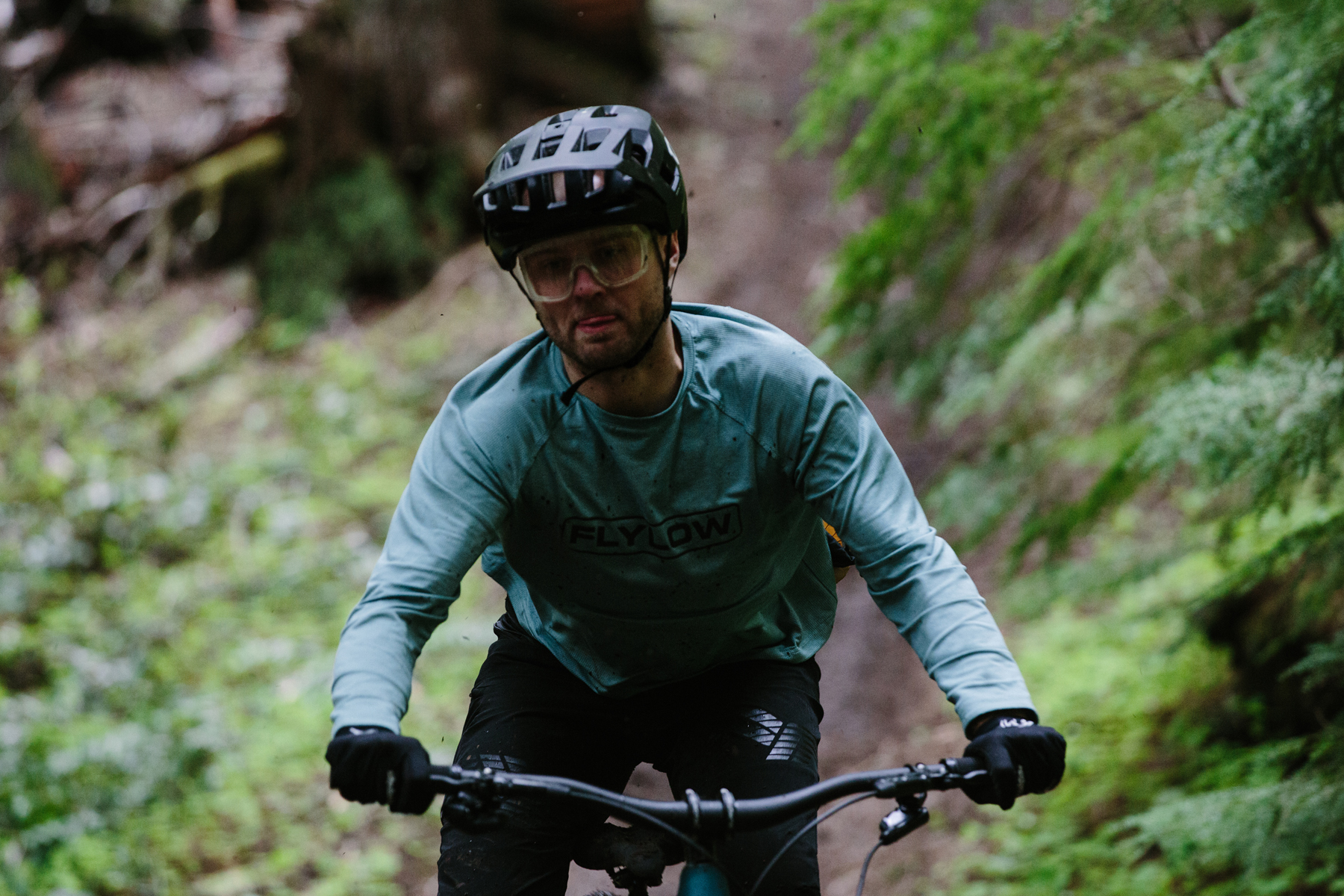
I also appreciated that Santa Cruz opted for bigger SRAM Code RSC brakes on the Hightower over the lighter but less powerful G2s. I did swap a 200 mm rotor onto the front for a little extra braking power, but that was an easy tweak. As I’ve mentioned a bunch before, I’m pretty sold on a more-is-more approach when it comes to brake power (within reason), particularly given that the weight penalty for bumping up a rotor size is so modest, but your mileage may vary.
The Glovebox storage system is also a nice addition. Particularly if you make an effort to stuff things into the forward part of the downtube (e.g., slide the tube purse up and then put more things in behind it) you can fit a good bit of stuff in there, and the included dividers do a good job of keeping things organized. I was able to (barely) get a lightweight jacket into the Glovebox with the tool wallet and tube purse removed, though it was a tight squeeze. It’s also worth bearing in mind that the Glovebox lid isn’t 100% waterproof if you’re subjecting it to very heavy spray.
And finally, while I think the “Matte Evergreen” finish on our review bike looks pretty good, the “Translucent Purple” alternate option (which I’d call more burgundy than purple) is especially striking in person. It’s a great color, with a ton of depth to it in brighter sunlight, and it subtly shows off the bare carbon fiber beneath — it’s killer.
Geometry Settings
As per usual for Santa Cruz, the Hightower’s flip chip makes for an overall subtle change to the Hightower’s handling. I spent most of my time on the bike in the Low setting, but the High one doesn’t transform the Hightower into a different feeling bike or anything like that. The High setting makes the Hightower feel slightly quicker handling and a little less stable at speed, but we’re definitely talking about minor variations on the same theme here. I imagine that most people will pick their preferred setting and mostly leave the Hightower there, but I also don’t see any real downside to having another setting option.
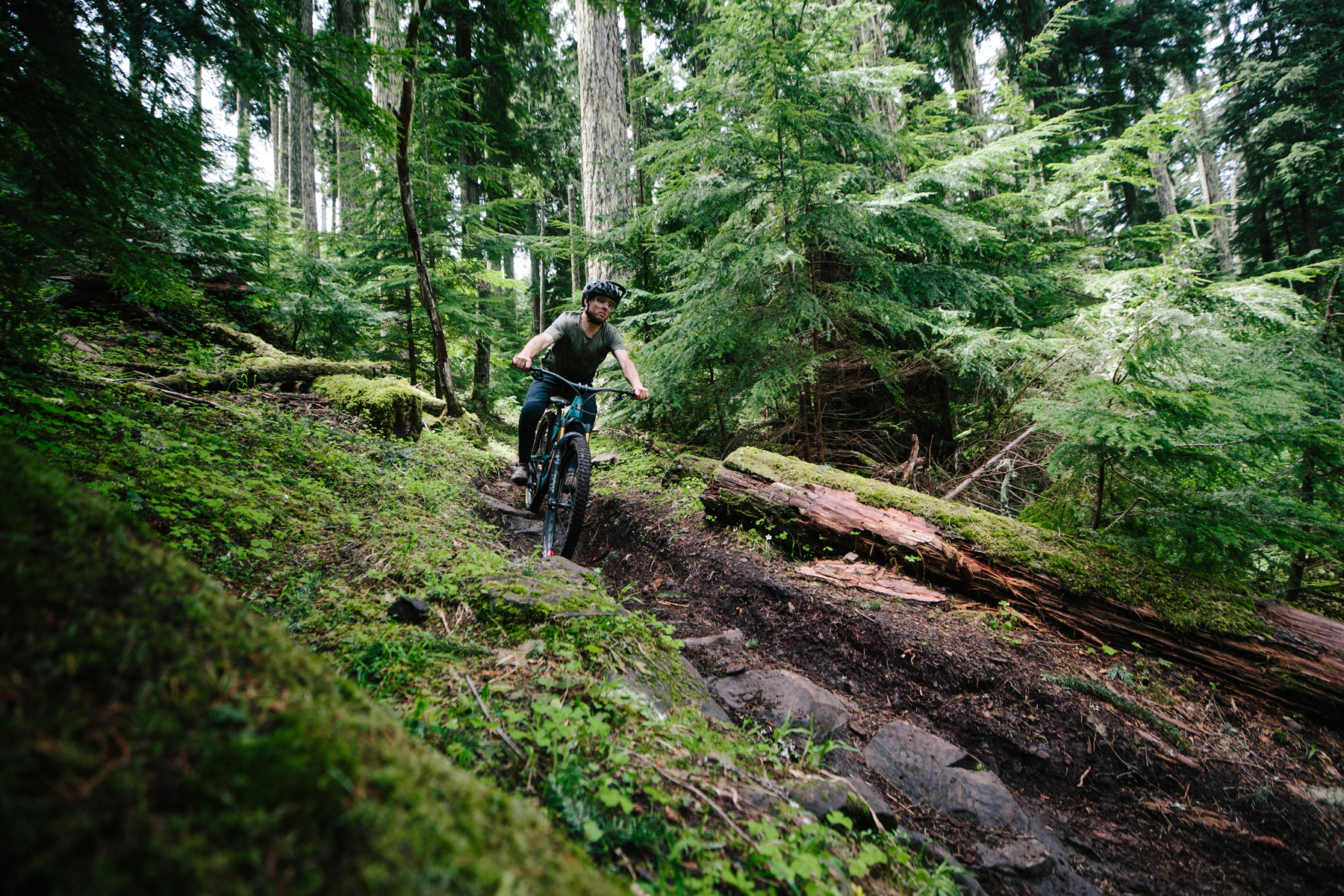
Who’s It For?
The Hightower is an easy bike to recommend to a lot of riders who want a bike that can do a little bit of everything. It’s not a bike that brings to mind many superlatives when it comes to any particular trait; it’s just well-rounded and versatile. The Hightower pedals reasonably well, is stable and composed enough to handle some fairly steep, technical riding while also still feeling lively and engaging when things mellow out, and does all that while still feeling approachable and forgiving, at least until you push it far beyond its comfort zone into terrain where a much more gravity-oriented bike would be more appropriate.
In a lot of ways, that makes it hard to say who the Hightower is for, exactly. With some other bikes, it’s much easier to paint a picture of the target audience. That’s not the case with the Hightower, which is frankly a testament to what Santa Cruz has done with the bike. It’s supposed to be the ultra-versatile, best-selling bike in their lineup that’ll work for a lot of people in a lot of different locales, and it’s a really good take on that.
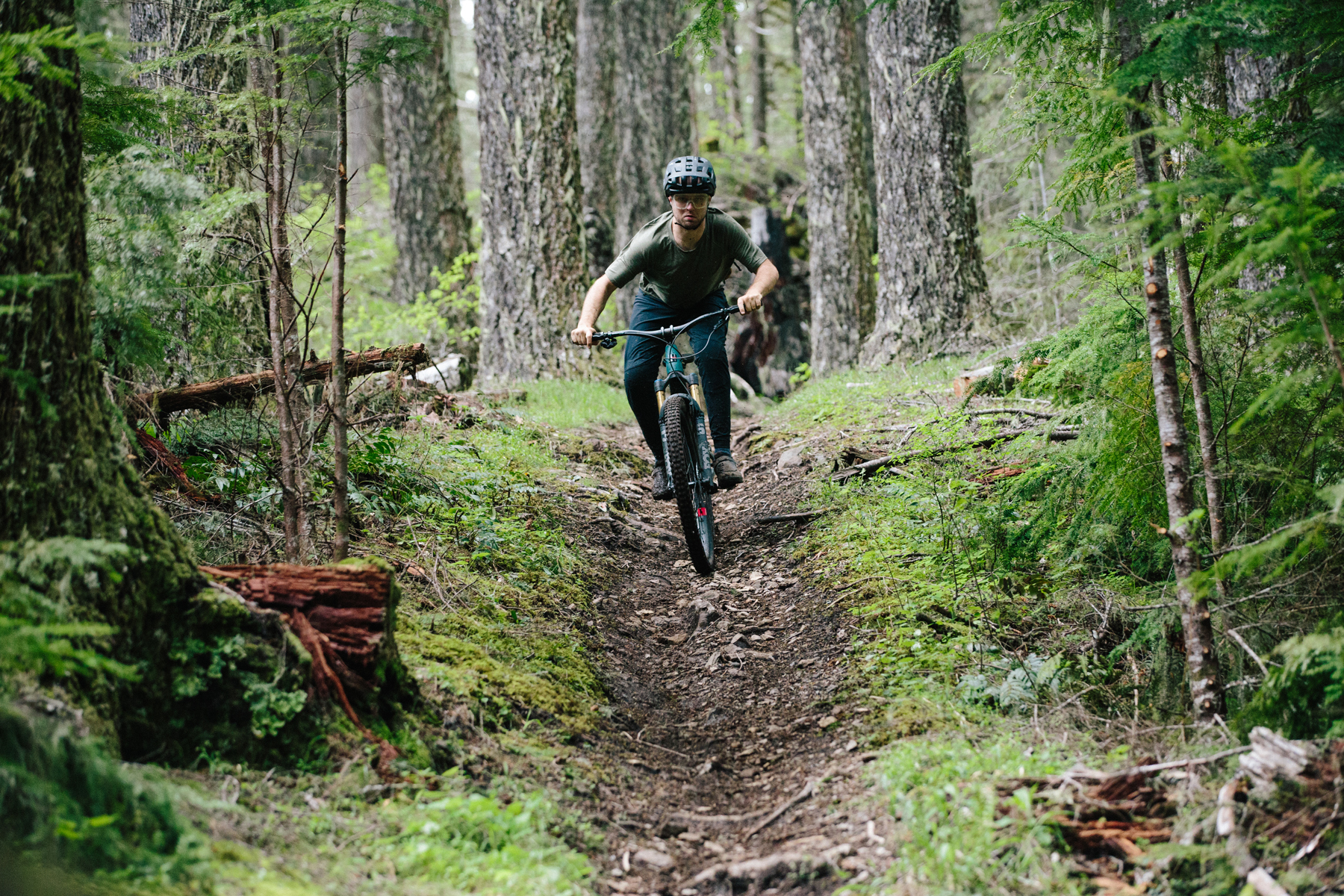
Bottom Line
Santa Cruz intended the Hightower to be a super versatile bike that a whole lot of different riders will get along with, and they’ve done a good job of hitting that mark. There are bikes that are snappier and more efficient, there are bikes that are more stable and confidence-inspiring in ultra-steep terrain, and there are bikes that are more nimble and playful at lower speeds. But there aren’t bikes that are all of those things, and as an all-around option that can handle a little bit of a lot of different kinds of riding, the Hightower is impressive.
The V3 Hightower also isn’t a wild departure from the prior-generation bike, but it didn’t need to be. The tweaks that Santa Cruz did make are for the better, and while V2 Hightower owners probably don’t need to rush out to upgrade to the new bike, it does offer some nice refinements and modernization of what was already a good, versatile all-rounder.
Deep Dive Comparisons
BLISTER+ members and those who purchase our Digital Access Pass can check out our Deep Dive comparisons linked below. Get our Digital Access Pass to view all our Deep Dives and Flash Reviews, or become a BLISTER+ member today to get access to that and a LOT more, including the best worldwide Outdoor Injury Insurance, exclusive deals and discounts on skis, personalized gear recommendations from us, and much more.

Deep Dive: Santa Cruz Hightower 3
We compare the Santa Cruz Hightower 3 to the Hightower 2, Guerrilla Gravity Smash, Santa Cruz Bronson, Yeti SB130, We Are One Arrival, Antidote Carbonjack, Orbea and Occam LT.
Blister’s Flash Reviews and Deep Dives are accessible to those who purchase one of our paid subscriptions
To get our comprehensive Deep Dives and our initial, unfiltered reports on new gear, become a member and receive many other services, deals, and discounts.
If you’re already an active member, please log in.
(If you’re already logged in and a member in good standing and seeing this message in error, please refresh this page in your browser.)


“But the stuff that has changed is pretty important” that’s quite an overstatement… little tweaks and not much more than that compared to the v2, which btw already had UHD for the latest frames, so that’s nothing new. The shock tunnel which is the biggest disappointment isn’t only larger on the bigger bikes (megatower, bronson) but also the smaller ones like tallboy and 5010, which only adds to the mystery why SC doesn’t make the hightower compatible with the X2 or coil shocks . Hopefully the leverage ratio tweaks will avoid the constant bottom out that plagued the v2 with the stock super deluxe. Overal quite disappointing updates which I’d call Hightower 2.5 not 3.
The fact that Santa Cruz has upped their pricing by something close to 30% in the last year or two is quite mind boggling. Yes there are many reasons for this increase like insane demand for bikes, parts and labor shortages, etc. I can understand a 10 or 15% increase, but this is insane. That a bike a retailing for $9799 would not even have the premium CC frame? Can Blister please investigate if a CC frame is even more expensive to produce than the regular C?
I love Santa Cruz and have owned 5 of them, but I feel like this greediness they have found lately is over the top.
I dont personally believe there is a dramatic difference is layup time for Carbon Bikes. That said, there CAN be a dramatic difference in the cost of the carbon and the resin they use, and it may require different patterns and layers. Which requires different cutting templates. They may just not be doing as many of those which drives the prices up. Personally, I would just have one carbon option and it would be the best and that would be that.
theres a 500gr diff in weight for sure and the C of the HT2 feels a bit flimsier, though these are handmade in china so your mileage may vary – other bikes, cheaper than these, are usually made in taiwan..
i think santacruz went a bit too far on the price to milk as much as possible (and didn’t over produce bikes). good on them and the bikes are good, but also, i didn’t upgrade and still wouldn’t, because it’s not a very good value unfortunately.
Agreed. Owned many SC’s over the years and on principal likely won’t buy another due to the premium price. One of the worst values on the market IMO.
Id like to know if the differences in the rear suspension travel is created by parts that will fit the V2. The problems discussed here are the problems I have on my bike. Low sensitivity and Bottom out resistance. I dont care about anti-squat. Thats what the shock lockout is for. If I can buy V3 Parts and put on my V2 to make it respond, I’ll spend that money. Of course IF they have changed mounting locations on the frame and/or the new v3 swingarm wont fit the v2 bikes, then that’s obviously not going to work.
I had your same complaints until I slapped a CC link in my frame. With the V3, SC does seem to attempt to address the ‘progressivity’ issue, however if we purely go by the LR numbers, it’s not nearly enough. Before you buy a new bike (or half of one), just try the $350 CC link. It is well worth the difference in performance, trust me (for best results, go back to stock 1 volume spacer and reset sag). https://cascadecomponents.bike/collections/santa-cruz-linkages/products/v2-hightower-lt-link
David, I am surprised that you find slacker seat tube angles easier to switch between seated and standing climbing.
My (vastly more limited) experience was the opposite: a steep seat tube angle lets me just straighten or bend my legs, and I have gone from up to down. On a bike with the saddle further back, I need to shift my hips forward, as well as up, requiring me to pull on the bars as I stand up.
There’s a sweet spot for sure. It’s not like slacker is always easier by any stretch, but the Hightower is pretty ideal from that standpoint for me personally, but I’m sure it varies person to person based on biomechanics and whatnot.
I still like steeper seat tubes for bigger Enduro bikes, but there are tradeoffs.